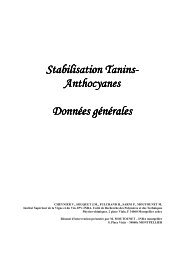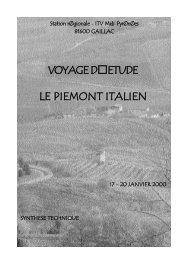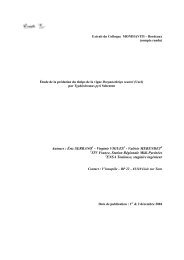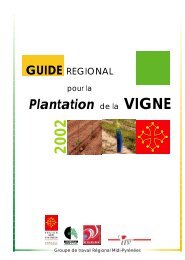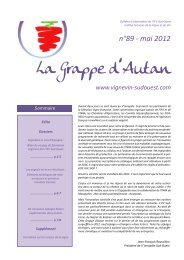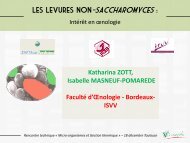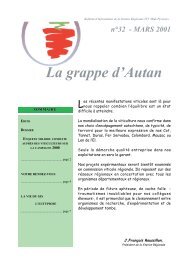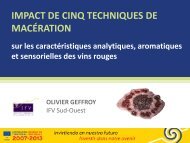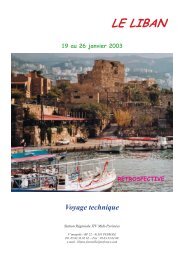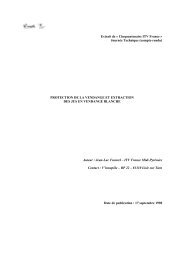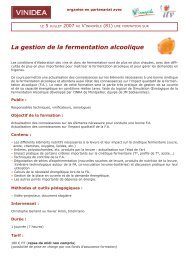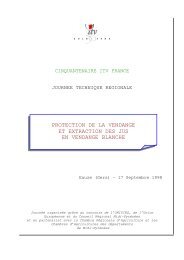Bioconversion de l'acide p-coumarique par Brettanomyces ...
Bioconversion de l'acide p-coumarique par Brettanomyces ...
Bioconversion de l'acide p-coumarique par Brettanomyces ...
Create successful ePaper yourself
Turn your PDF publications into a flip-book with our unique Google optimized e-Paper software.
RESUMECe travail étudie la bioconversion <strong>de</strong> l’aci<strong>de</strong> p-<strong>coumarique</strong> en 4-éthylphénol <strong>par</strong> une souche<strong>de</strong> <strong>Brettanomyces</strong> bruxellensis, levure <strong>de</strong> contamination <strong>de</strong>s vins. Deux métho<strong>de</strong>s analytiques(HPLC/UV et GC/MS) ont été optimisées pour suivre la cinétique <strong>de</strong> la réaction. L’aci<strong>de</strong> p-<strong>coumarique</strong> présente un problème <strong>de</strong> quantification. Son instabilité aux températures élevéeset son estérification avec l’éthanol du vin ont été montrées, ainsi que son adsorption sur les<strong>par</strong>ois <strong>de</strong>s levures. L’étu<strong>de</strong> du bilan matière <strong>de</strong> la bioconversion montre plusieurs étapesréactionnelles. La bioconversion en 4-éthylphénol ap<strong>par</strong>ait comme unique voie d’utilisation<strong>de</strong> l’aci<strong>de</strong> p-<strong>coumarique</strong> <strong>par</strong> la souche testée. Le mo<strong>de</strong> d’agitation, la phase <strong>de</strong> croissance, letaux <strong>de</strong> la population levurienne, ainsi que la présence <strong>de</strong> phénols volatils ont montré un effetdirect sur la vitesse <strong>de</strong> la réaction. Enfin, l’adsorption <strong>de</strong> l’aci<strong>de</strong> p-<strong>coumarique</strong> sur le PVPP aété présentée comme un moyen <strong>de</strong> lutte contre l’ap<strong>par</strong>ition du 4-éthylphénol dans les vins.Mots-clé : <strong>Brettanomyces</strong> bruxellensis ; aci<strong>de</strong> p-<strong>coumarique</strong> ; 4-vinylphénol ; 4-éthylphénol ;bioconversion ; adsorption ; bilan matière ; cinétique ; œnologie.ABSTRACTThe aim of this work was the study of p-coumaric acid bioconversion into 4-ethylphenol by<strong>Brettanomyces</strong> bruxellensis as a contamination yeast of wine. An HPLC/UV and a GC/MSmethod were optimised to follow up the reaction kinetics. P-coumaric acid presents manyquantification problems, and it was shown to be instable at high temperature. Its esterificationwith wine éthanol as well as its adsorption on yeast cell walls were <strong>de</strong>monstrated. The studyof biosynthesis material balance showed several steps of reaction. The conversion into 4-ethylphenol seems to be the only pathway of p-coumaric acid to be used by <strong>Brettanomyces</strong>stain tested. The agitation, the growth phase, the yeast population concentration, as well as thepresence of volatile phenols have shown a direct effect on reactions rate. Finally, p-coumaricacid adsorption on PVPP was presented as a usefull method to prevent 4-ethylphenoloccurrence in wine.Keywords : <strong>Brettanomyces</strong> bruxellensis ; p-coumaric acid ; 4-vinylphenol ; 4-ethylphenol ;bioconversion ; adsorption ; material balance; kinetics ; œnology.



